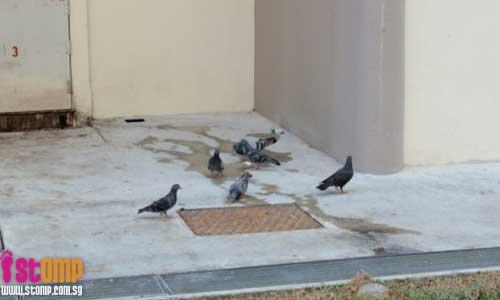
Bird droppings can be seen everywhere at Ghim Moh Estate due to the burgeoning pigeon population there.
According to a STOMPer, hordes of pigeons can be seen every day rummaging through bins.
He says:
"This picture was taken at Block 2, Ghim Moh Road.
"You can see many pigeons in this estate. Every day, I see hordes of pigeons rummaging through the bins.
"Some residents leave bags of leftover food near the waste bin area and when the pigeons eat the food they will leave a trail of food remnants which would later attract rats to this area.
"You can also see bird droppings on the floor, the parapet and even on bamboo sticks used to hang the laundry.
"If nothing is done, I fear the pigeon population here will soon outnumber the human population."
Related post: Neighbour always leaves food for birds! (21st January 2009)
Uncle feeds pigeons despite 'No Feeding' sign at Bencoolen Street (22nd January 2009)
Crazy pigeon is not afraid of people and steals food from their plates (23rd January 2009)
For some reason, pigeons are getting a lot of attention on STOMP lately.
While I think the person who submitted this is exaggerating (the small flock in the photo can hardly be considered a 'horde' of pigeons), it is true that feral pigeons (Columba livia) can become a serious nuisance in urban areas, and threaten the cleanliness and hygiene of a neighbourhood.
However, as hinted at in the post, this problem is partly a result of human behaviour. If leftover food was properly disposed of, the amount of food available to these birds would be greatly reduced, and also reduce the risk of attracting vermin.
Pigeons can be extremely prolific, since they reach sexual maturity at a young age, and can breed several times in a single year. The wild form of the pigeon, known as the rock pigeon or rock dove, tends to nest on cliff ledges. In urban area, the proliferation of man-made cliffs in the form of high-rise buildings has been to the feral pigeons' benefit. A number of strategies have been employed to keep pigeons away from buildings, or to prevent them from selecting certain spots as breeding sites, with varying amounts of success.
I still like to hope that one day, we will get to see peregrine falcons (Falco peregrinus breeding in urban Singapore, feeding on the flocks of pigeons like their counterparts in so many other cities around the world. Not very likely, I know, but one can always hope.
Oh, and if that little flock is considered a 'horde' of pigeons, I wonder what that person would have to say about natural spectacles such as this:
European starlings (Sturnus vulgaris), England
Red-billed quelea (Quelea quelea), Zimbabwe
And of course, who can resist thinking of Alfred Hitchcock whenever the subject of large flocks of birds is brought up?